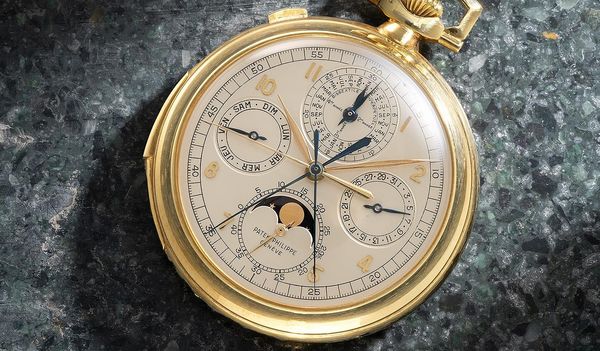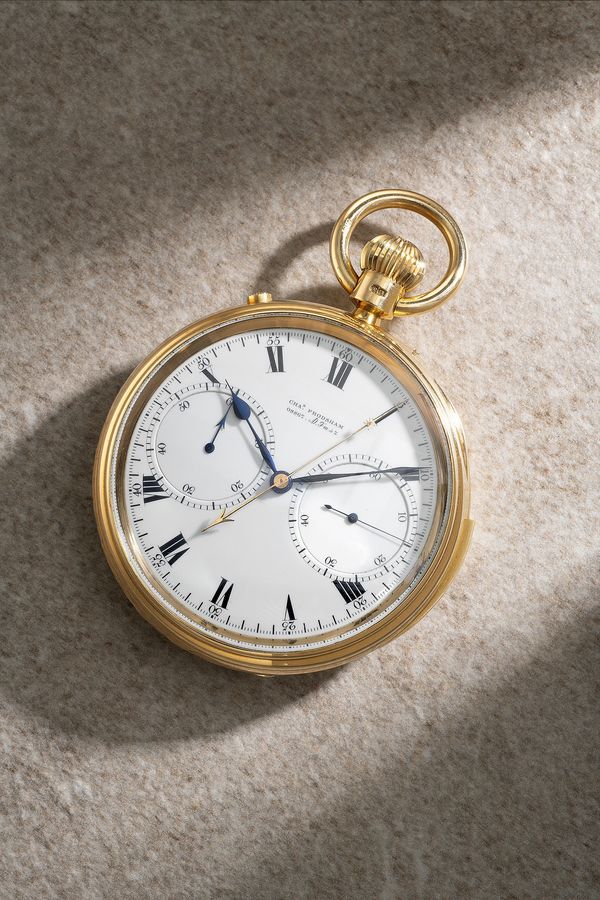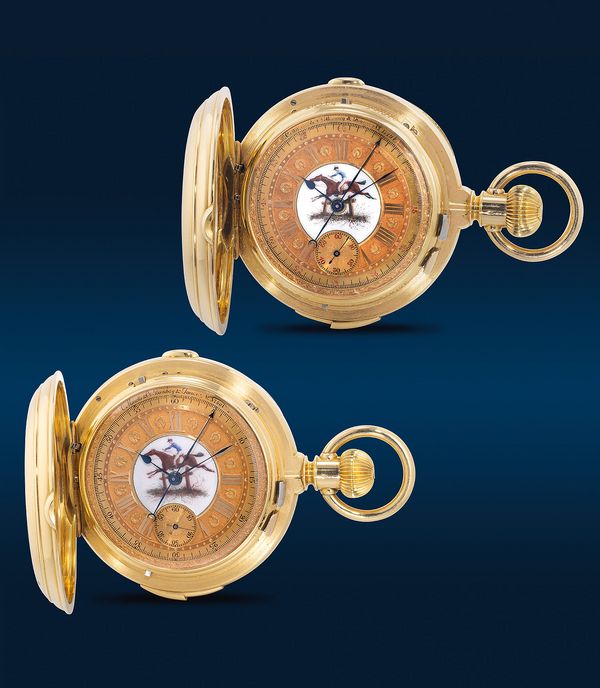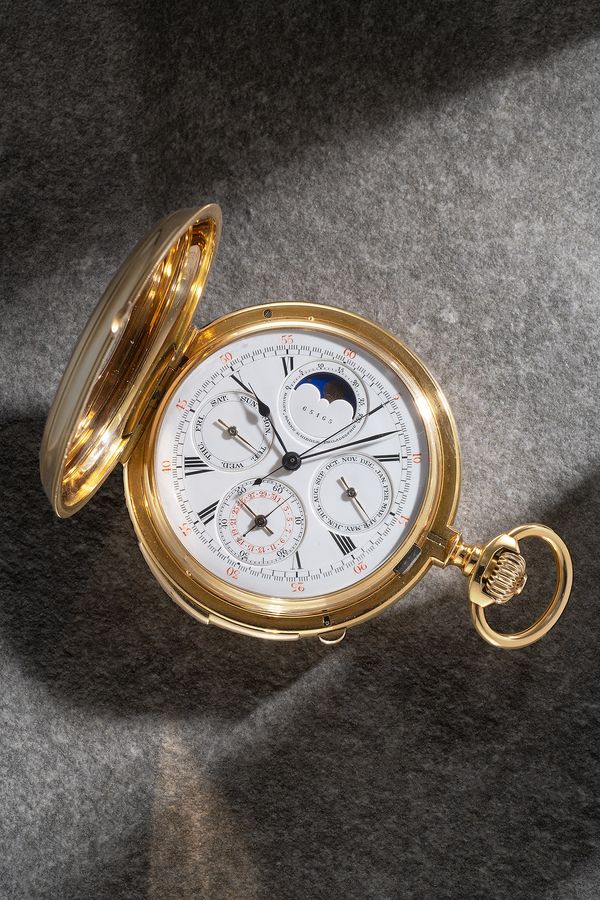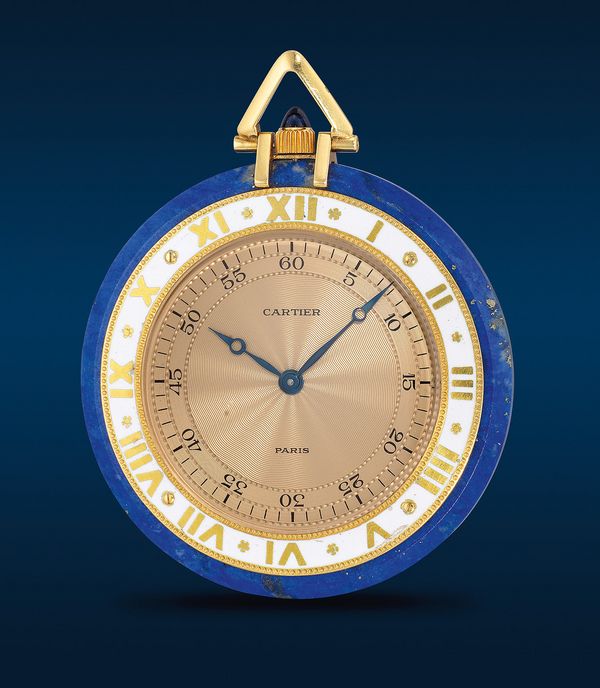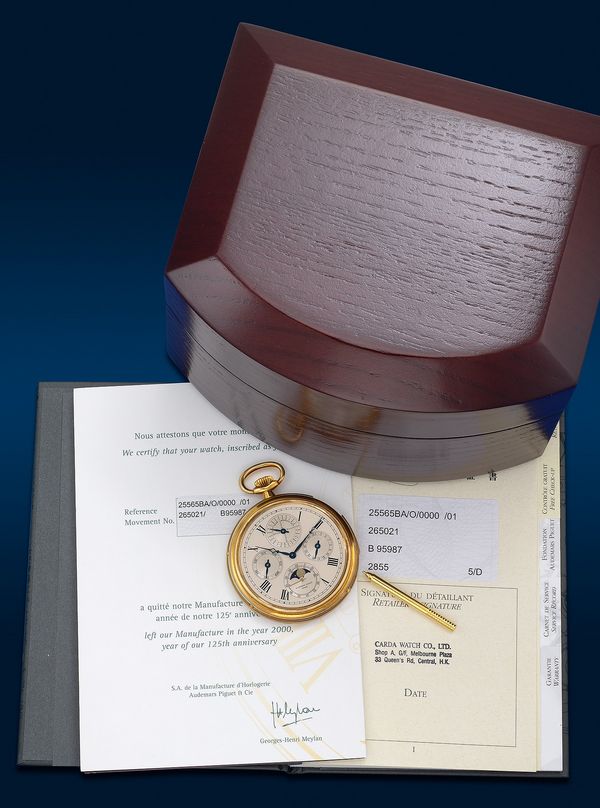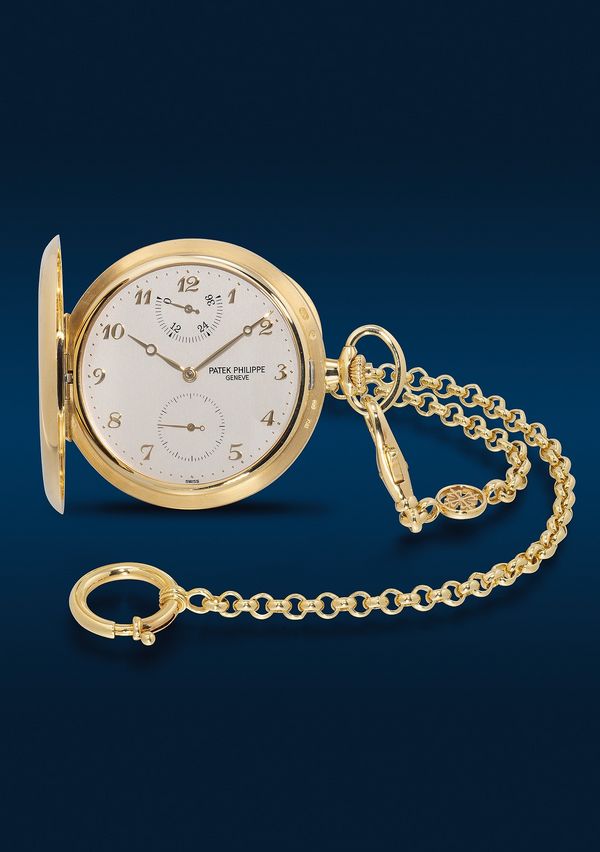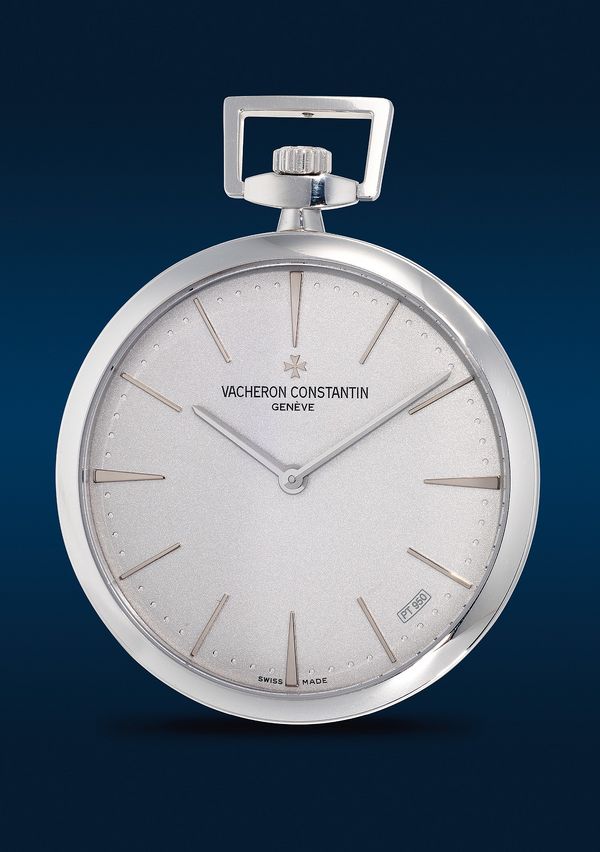The PHILLIPS Hong Kong Watch Auction: XVIII, takes place on May 24 and 25, 2024, at our West Kowloon headquarters. The auction includes more than 280 of the world's finest watches – and though we are loath to boast, we truly think it's one of the best catalogs we've ever put together. We'll be highlighting a number of the most interesting lots and stories featured in the sale right here, including the wide variety of pocket watches featured below.
We’ve already highlighted many of the different wristwatches and important clocks available during the Hong Kong Watch Auction: XVIII, but our latest editorial places a spotlight on perhaps the most underrated division of collecting culture today – the humble pocket watch.
Lot 862: A 1952 Patek Philippe Grand Complication Pocket Watch Ref. 767 in 18k Yellow Gold
Estimate: HKD $3,200,000 - 6,400,000
A trip to the Patek Philippe Museum in Geneva, a temple to one of the world's most important and prestigious horological collection will surely take your breath away with the splendor of the firm's technical prowess and craftsmanship, especially the immeasurable collection of pocket watches. From embellished pieces with enamels and engravings, lavish ornamented works of art, to automatons, these creations of horological complications have always held great fascination and punctuate the history of Patek Philippe.
Any addition to the basic indications – hours, minutes, and seconds – is considered a complication. These intricate functions may require one or more additional hands to indicate other time zones or the astrological events that mark time divisions: day, date, month, leap year, and lunar cycle. They may indicate time by repeating mechanisms sounding the precise measurement of small intervals of time. They may also measure time with accuracy.
Patek Philippe's first ever horological complication pocket watch with not one, not two, but three complications was made in the late 19th century. One of such is the Triple Complication and part of the Patek Philippe Museum collection is No. 47'721, the hunter case pink gold pocket watch was bestowed with a minute repeater, a perpetual calendar, and a chronograph powered by a 20''' Piguet Freres movement. It was also one of the first pocket watches with instantaneous calendar ever made. Exhibiting all the characteristics that made Patek Philippe one of the foremost horological firms of the 19th century, it was shown at the 1876 Centennial International Exhibition in Philadelphia.
Fast-forward to the first step away from the post-war period, Patek Philippe refreshed the line of Triple Complication into modern age with the launch of the reference 767 in 1951. A wonderful evolution from the maison's traditional horological past, the “Moderne” reference was open-faced with clean and elegant lines, the bows are prominent and arched with integrated crown guards. 50mm in diameter, the three parts with a snapped caseback, majority of the reference 767 were crafted by master Geneva watchmaker Antoine Gerlach (Key number 4). Fitted with important movements found in inventory from the 20's and refurbished, these pocket watches were cased after the 1950s all into yellow gold cases, each with their own unique nuance. The dials were also unique to each, such as the variation of Arabic and baton hour markers, some even feature a moon phase at 6 o'clock instead of 12.
To the best of our knowledge, only 7 examples of the ref. 767 have ever appeared publicly, first exemplifying its rarity, but most important of all, it puts the spotlight on its most outstanding feature of this present ref. 767. The only known example to feature a double-split chronograph mechanism, a total of 5 hands mounted on the central pinion: Hour, Minutes, Chronograph, and Double-split hands.
Boasting incredible resemblance to the legendary perpetual calendar chronograph ref. 1518 with attractive Arabic numerals that marks the hours indexes. According to our research, the present specimen is possibly the only example to feature a French calendar , perhaps a special request by a distinguished collector, and was sold on 8th July 1952, being one of the earliest known example. The pocket watch was also prominently illustrated in the important Patek Philippe Geneve book by Martin Huber & Alan Banbery. According to our research, we believe that this very example was part of the Seth G. Atwood's private collection. He founded the Time Museum Rockford in the United States in 1971, which later became one of the leading horological museums in the world with nearly 1,500 pieces of important horological pieces. The hall of fame from the collection includes the Patek Philippe Henry Graves Supercomplication, the quarter-repeater by Thomas Tompion and the Breguet Sympathique Clocks. An exceptional and highly regarded collector who collected the best of the best, it is absolutely no surprise to anyone that this particular museum-worthy ref. 767 was previously part of his possession.
Stunningly preserved in all its glory, the 1518-esque engraved enamel dial is exquisite and impeccable with matching movement number engraved on the underside. Setting this example apart from the rest is the vividly stamped key number 9 on the inner caseback. We learn that the present ref. 767 is crafted by legendary case maker Emile Vichet widely known for his creation of the highly valued and sought-after 1518 and first series 2499. The Acoustic of this minute repeater is warm and pleasing to the ear. 11 hour strikes, three quarter strikes and 14 minute strikes, a constant tempo as each chime rings through the ears of generations. The Stern family for decades delivers the purest of chimes toward its long history of watchmaking. All is defined by solely the sound that rings to your ear, and none does it better than Patek Philippe.
Lot 891: A Circa 1901 Charles Frodsham Minute-Repeating Chronograph Tourbillon Pocket Watch in 18k Yellow Gold
Estimate: HKD $480,000 - 960,000
Charles Frodsham is a highly esteemed English watchmaking firm since the latter half of the 19th century. In 1854, Charles Frodsham succeeded Benjamin Lewis Vulliamy as the Superintendent and Keeper of Her Majesty's Clocks at Buckingham Palace, serving the King, the Prince of Wales, and Queen Alexandra. Following Charles's passing, his son Harrison Mill Frodsham took control of the firm and incorporated it as Charles Frodsham & Co. Ltd. in 1893. Harrison Mill Frodsham proved to be a skilled horologist and businessman, and the company continued to thrive as a maker of brilliant timepieces.
The present lot represents an exceptional example of the iconic Charles Frodsham tourbillon pocket watch. Bearing the serial number No. 08'867, currently, only 12 of these watches have re-emerged in the market, while the rest are either held in private collections or remain in the possession of descendants of the original owners. This remarkable timepiece incorporates a minute repeater, split-seconds chronograph, and a one-minute tourbillon, which the monumental movement of this watch is also featured on the official Charles Frodsham website. During their production, these watches were among the most intricate and expensive English timepieces available, retailing between £200 and £350.
The watch is in magnificent condition, displaying a distinct stepped case, unrubbed hallmarks on the bow and winding stem, and an incredibly pristine enamel dial devoid of any blemishes. Many Frodsham watches particularly feature the coded letters "AD Fmsz" on the dials and movements. This cryptogram corresponds to 1850 when Charles Frodsham introduced his new caliper watch and was subsequently used as a symbol of the highest quality.
The inner caseback bears hallmarks including the Leopard's head, representing London's Assay Office, the crown symbolizing 18-carat gold, the letter "f" serving as a date stamp corresponding to the year 1901, and "HMF" denoting Harrison Mill Frodsham as the casemaker. Notably, the three-quarter plate movement of the watch features interesting engravings such as the business premises of Charles Frodsham at "115 New Bond Street, Late of 84 Strand".
In 1902, the present watch underwent a time trial at the Kew Observatory (now known as The King's Observatory) in Richmond, Surrey. It was subjected to different temperatures and positions and achieved the highest A certificate with 78.4 marks, ranking 8th out of 13 watches in the "Complicated watches" category . Notably, it has been sitting in the same collection for nearly 3 decades by a very prominent family. Today, Charles Frodsham continues to craft wristwatches of exceptional quality, with their iconic Double Impulse Chronometer garnering significant success in auctions. It stands as a pinnacle of English watchmaking.
Lot 1013: A Circa 1987 Paul Ditisheim Tourbillon Pocket Watch with Small Seconds in 18k Yellow Gold
Estimate: HKD $480,000 - 960,000
Renowned Swiss watchmaker Paul Ditisheim (1868-1945) revolutionized precision timekeeping through his chronometer research and innovations like the affix balance. By 1903, his watches were honored by the Observatories of Kew and Neuchâtel. In 1912, he achieved the world chronometric record at the Royal Kew Observatory. Ditisheim's contributions to horology were immense. In 1892, he established his own manufactory in La Chaux-de-Fonds. Ditisheim tirelessly researched and published works on the effects of atmospheric pressure, temperature, and magnetism on chronometric performance. His pioneering improvements in chronometer design included overcoil springs, Guillaume balances, and pivoted detents. Ditisheim's meticulous refinements propelled timekeeping to new heights, as proven by his record-setting accuracy prizes.
Ditisheim produced very few tourbillons, with noted horology historian Reinhard Meis documenting merely 8 examples . This incredible rarity, along with its Grether carriage, chronometer escapement, and Guillaume balance, suggest potential Girard-Perregaux origins. Girard-Perregaux pioneered the three gold bridge movement in 1867, a layout exposing the bridges in a mesmerizing display of horological artistry. The innovation won a gold medal at the 1889 Paris Exposition. Ditisheim adopted this architecture for the present tourbillon pocket watch.
Tested at the Kew Observatory in 1916 and 1917, it received Class A certificates with exceptional scores as shown on the accompanying certifications, affirming its superlative timekeeping. The movement dazzles with arrow-headed bridges over machined plates and steel carriage. A bi-metallic Guillaume balance, pivoted detent, and blued overcoil optimize precision for this exceptionally accurate 1-minute tourbillon.
The yellow gold hunter case exquisitely captures the spirit of the Belle Epoque with masterful hand chasing imparting artistic beauty. On the front, a central panel depicts winged putti joyfully playing with a bird amidst butterflies dancing over flowers. Garlands of blossoms and verdant foliage frame the idyllic scene. A ribbon bow and vase provide finishing accents, with delicacy and vitality animating the composition. On the reverse, music trophies wreathed in flowers and leaves evoke the sounds that might accompany such an enchanting moment. The floral chasing extends fluidly from the case onto the band, enveloping the entirety with vivacious neoclassical ornamentation. The present example is possibly part of the collection from the Time Museum, Rockford USA as prominently illustrated in the Das Tourbillon book by Reinhard Meis in pages 146-147.
Further accompanied by the Observartoire Astronomique Bulletin des Marches Neuchatel, Bulletin des Marches from The National Physical Laboratory Teddington, Middlesex UK and its original red leather box. Together, the sublime horology and craftsmanship transcend function, elevating the timepiece into a breathtaking objet d'art that evokes the soaring creativity of the era. The Belle Epoque springs to life in this exceptionally well-preserved 19th century Paul Ditisheim pocket watch, transformed through beauty and visionary artisanship into a captivating ornate treasure.
Lot 1048: A Pair of Circa 1890 Marcks & Co Grande Sonnerie Chronograph Keyless Pocket Watches in Yellow Gold
Estimate: HKD $400,000 - 800,000
In 1858, the British Crown took back the charter from the East India Company and began ruling India directly, while Queen Vitoria was further proclaimed as Empress of India in 1877, the crown's undoubted sovereignty brought the first period which marks the predominance of British Horology. In 1890 until 1947, a great Swiss era followed for the Indian market flourished with Swiss made timepieces. The landscape of the country during the mid-19th century was also bustling, divided into over 562 Princely states, each one was headed by either a Raja or Maharaja, Rana, Nizam; all which their magnificence and wealth are legendary.
Being the key importer of Bombay, Marcks and Co. was the sole source for royalties and aristocrats to get their hands on majestic timepieces such as grand complication, perpetual calendars and repeaters. The pocket watches during that era had specific characteristics, solid gold hunter-cased and often richly decorated with coat of arms, jeweled or arabesque and motifs. Curvettes were also engraved with flower motifs near the opening groove. The dials were often embellished with painted portraits of nobleman in enamel. It is also notable that the major supplier of these high quality movements was one of the most established master who specializes in Grande Complication, Henri Grandjean. In 1851, at the first Universal Exposition in London, Grandjean received a First Class medal. His list of medals continues until 1868, the year in which the company won an award for its marine chronometers. A name closely connected to Le Locle, theres even a street named after the master.
Commissioned by likely a Maharajah or a Nizam in circa 1890 to C. Marcks & Co., Bombay & Poona, the present exquisite example from Marcks & Co. is a matching pair of Grande and Petite Sonnerie striking chronograph hunter-cased keyless pocket watches. The heavy gold full hunter-cased timepieces are impressive and captivating in its own right. The Grande and Petite Sonnerie striking complication is unquestionably the highest of all complications and represents the very finest watchmaking skills. Combining a quarter striking mechanism with a minute repeater, it provides an audible striking as it passes each quarter hour, and a minute repeating function is available on demand via the slider on the case band. The former of the set is fitted with minute repeater and the latter with quarter repeater, both activated by the striking and silence selector on the edge of the bezel.
Comissioned by a cultured nobleman who perhaps was well versed in the customs and manners of English culture especially horse racing. Evidently engraved with horse shoes as hour markers around the gold champlevé dial, a graceful jockey in blue attire is painted in the center of each timepieces.
An absolutely charming and possibly unique pair presented in excellent overall condition and kept in a private collection since it last appeared publicly. The hallmarks remain deep and intact, in fact, both are stamped with the domestic gold Helvetica hallmark with a small L, the stamp denotes that the piece was from the period of 1880-1934 from Le Locle.
Lot 969: A Circa 1883 Patek Philippe Grand Complication Pocket Watch in 18k Rose Gold
Estimate: HKD $320,000 - 640,000
This pocket watch holds a significant place in the history and evolution of Patek Philippe's perpetual calendar system. During the 1880s, Patek Philippe made remarkable strides in developing and refining complications in their timepieces, marking a significant chapter in the company's defined history by unwavering commitment to innovation and horological excellence.
Manufactured in 1883, before the company patented its perpetual calendar mechanism in 1889, this watch stands as a testament to the early development of this remarkable feature. Patek Philippe's dedication to perfecting the perpetual calendar resulted in highly accurate and reliable timepieces . They focused on enhancing the user experience, incorporating intuitive mechanisms to adjust calendar displays easily. These early perpetual calendars showcased the brand's technical prowess, accounting for leap years, irregular month lengths, and lunar phases.
From 1889 to 1904, Patek Philippe secured several patents for various watch movement mechanisms, solidifying its reputation as a creator of exceptional timepieces. The present watch, with its fusion of the perpetual calendar for astronomical functions, the chronograph for precise timing, and the distinct minute repeater for auditory pleasure, represents the pinnacle of watch manufacturing during that era. Its pristine original condition further adds to its overall appeal.
Specially crafted for Bailey, Banks & Biddle, a renowned American jewelry and luxury goods retailer based in Philadelphia, this extraordinary timepiece exemplifies the brand's long-standing heritage associated with elegance and superior quality. Established in 1832, Bailey, Bank & Biddle has catered to discerning customers seeking exquisite jewelry, timepieces, and other luxurious accessories, earning a reputation for excellence.
It's worth noting that only a minuscule number of Patek Philippe ' triple complication' watches have ever been publicly known or offered for sale at auction. With its exceptional quality and rarity, the present watch holds significant value and would undoubtedly be a prized addition to any serious watch collection.
Lot 876: A Circa 1930 L. Leroy & Cie. Grand Complication Pocket Watch in 18k Yellow Gold
Estimate: HKD $160,000 - 320,000
Louis Leroy was born in 1860 and considered by many as the equivalent of Breguet in terms of aesthetic and technical innovations. In 1900 he created the Leroy 01, the most complicated watch ever made with an astounding 24 complications on two dials, other than the chiming complications such as minute repeater, grande and petite sonnerie the Leroy 01 also indicated time in 125 cities, seasons, the winter and summer solstice, spring and autumn equinox a perpetual calendar a hygrometer, a barometer and even an altimeter. The Leroy 01 also had 3 interchangeable celestial charts representing the sky over Paris, Lisbon and Rio de Janeiro. The Leroy 01 remained the world's most complicated timepiece until 1989 and Patek Philippe's caliber 89.
With the watchmaking expertise, Leroy has fruitful collaborations with some of the most esteemed observatories worldwide . On 26th August 1932, the present watch was submitted for rating at the Observatory of Besançon and achieved an impressive score of 169.35 points. Additionally, it received a first-class rating, as indicated by the engraving on the cuvette and most importantly, the prestigious viper's head hallmark stamped on the movement by the Observatory of Besançon. Not once, but twice it has been tested and stamped. Indicated by the different orientations of the stamp, an "upright" position corresponding to 1st Classe, and the viper facing right indicating 3rd Classe, a testament to the watch's success during the two trials.
While one might expect a chronometer-grade movement to be found in a time-only watch, the current timepiece boasts an impressive minute repeating perpetual calendar chronograph movement. This is a remarkable feat of mechanical prowess, especially considering it was produced in the 1930s. The engine-turned dial adds to the watch's allure and is exceptionally well-balanced. Notably, it also features a rare digital year indication for 21 years at the 6 o' clock aperture, showcasing the watch's exceptional excellence. As the year ring starts from "1964", it is worth noting that the original owner replaced it with a new one 34 years after acquiring the watch.
Lot 836: A Circa 2000s Cartier Pocket Watch in Gold and Lapis Lazuli
Estimate: HKD $160,000 - 260,000
Cartier sustains their legacy of producing the most refined and opulent jewelry timepieces, as exemplified by this exquisite pocket watch encased in lapis lazuli with a yellow gold bow. Its case number and “Cartier Paris” engraving is crisp, and French hallmark indicated by an eagle head found on the bow remains deep. Its dual chapter ring continues a design first introduced in the 1920s that epitomized Cartier's avant-garde spirit. The double chapter ring made its debut in Cartier's collection circa 1911, around the time Edmond Jaeger began supplying the maison with pioneering ultra-thin movements like the famous 1.38mm cal. 145. This allowed for new dimensions of elegant restraint.
Yet even with new slender proportions, Cartier indulged in beautiful intricacy as seen in the guilloché dial of this example. The gorgeous white enamel The outer chapter ring contains alternating Roman numerals and delicate floral motifs in gold, while the inner ring with Arabic numerals add complexity. The lapis lazuli case furthers the richness – its vibrant blue hue contrasting sublimely with the pristine gold dial.
At once opulent yet refined, this rare dual chapter ring pocket watch crystallizes Cartier's flair for blending luxury craftsmanship with timeless style. The lapis lazuli case is incredibly well-preserved, which is hard to come by. Both a jeweled objet d'art and feat of precision horology, it remains a coveted symbol of the era.
Lot 877: A Circa 2000 Audemars Piguet Quantieme Perpetuel Repetition Minutes Ref. 25565BA in 18k Yellow Gold
Estimate: HKD $160,000 - 320,000
The present Audemars Piguet watch evolved from a long tradition of horological excellence, a masterpiece produced by a master watchmaking brand. It is interesting to note that in the early 1970s, despite the decline in demand for pocket watches due to the Quartz crisis, Audemars Piguet continued producing extraordinarily costly, grand complication pocket watches, beautifully embodying the brand's expertise in complications.
A legacy that begin from 1875, the present yellow gold grand complication pocket watch is a modern interpretation that celebrates the Le Brassus brand's 125th anniversary. During the year 2000 , Audemars Piguet held a traveling exhibition that features 125 of their creation that illustrates the manufacture's achievements. At the same time, a limited series was also made available in conjunction with this important milestone.
Kept in a private collection since its birth, the present exceptional yellow gold minute repeating perpetual calendar pocket watch embodies the brand's beauty and masterful craftmanship. Extra flat in its dimension yet packed with feats, the ref. 25565BA is supremely elegant. A perfect balance with pleasing Roman numerals that surrounds the serene sunken sub-dials, the delicate play of petite typography within displays information with clarity.
Numbered 10 and preserved in exceptional condition, the ref. 25565 chimes with great tone and clarity. A complete set that has been treasured by its original owner for years, a warm layer of patina can be appreciated throughout the pocket watch. A rare opportunity for all collectors to own a horological masterpiece, the consignor of the present watch will also be giving the proceeds of the sale to various charities.
Lot 977: A Circa 2018 Patek Philippe Pocket Watch with Power Reserve in 18k Yellow Gold
Estimate: HKD $130,000 - 200,000
In today's world, it is confident to say that wristwatches dominate the realm of horology. Pocket watches, once highly regarded in the 19th century, have been somewhat overlooked by collectors, given their perceived antiquity and decreased practicality. Consequently, only a few watch manufacturers dedicate their resources to crafting fine pocket watches, as their popularity has waned over time. However, Patek Philippe, renowned for its legendary watchmaking heritage, remains committed to exploring the realm of pocket watches, particularly through their Rare Handcrafts collection.
The present timepiece serves as a delightful testament to Patek Philippe's dedication to preserving the traditions of fine watchmaking. While contemporary collectors often seek intricate complications, the reference 983 exudes elegance with its practical power reserve indication. Retaining a classical charm, the dial is adorned with meticulously crafted applied gold Breguet numerals.
Although it was introduced in 1990s, this reference continues to be produced by Patek Philippe with very few examples resurfaced at auction. Remarkably, this particular example is fresh-to-the-market and preserved in excellent condition. To complement its allure , the watch is accompanied by a matching Patek Philippe 18K yellow gold watch chain, making it a perfect modern pocket watch for discerning collectors.
Lot 1015: A Circa 1900s J. Ullmann & Co. Grande Sonnerie Pocket Watch, Made for the Chinese Market
Estimate: HKD $120,000 - 240,000
Founded in Hong Kong in the 19th century by Swiss native Jacques Ullmann, J. Ullmann & Co., Hong Kong, Shanghai, Tientsin was established against the backdrop of the expansion of Swiss watchmaking in the Chinese market. Swiss watches had become very popular in the China region by mid-19th century, partly due to the success of the Bovet brand, selling under the Chinese name “Bo Wei” and became synonymous with “watch” in Chinese culture. By the late 1880s, J. Ullmann & Co. has set up a store in the heart of the Central district in Hong Kong, at 74 Queen's Road Central. After Jacques Ullmann passed away in 1909, J. Ullmann & Co. continued to expand in China under Bernheim Ullmann, opening branches in Shanghai and Tientsin.
Cased in an exquisitely engine-turned yellow gold hunter case, the present pocket watch features an intricately engraved hinged gold cuvette, a signature J. Ullmann design. The white enamel dial is characterized by a classic design with Roman numerals, subsidiary seconds, and luscious gold hands. Fitted with a gilt keyless lever movement, the present watch is presented with the Grand Sonnerie, meaning that it can automatically chime the hours on every hour and hours and quarters on every quarter. It is often regarded as a grail complication by collectors and hearing it on a century-old pocket watch is always astounding. The present pocket watch also features a carillon minute repeater, meaning the quarters are chimed on three gongs and not on the usual two making it even more complex, rare and collectible . The going and striking trains wound alternately by the crown, quarter striking and minute repeating with three hammers on three gongs.
Preserved in excellent condition, this elusive and rare timepiece offers much more than an exceptional mechanical timekeeping instrument but is an object of art imbued with history and heritage, and it would surely appeal to the horological enthusiasts.
Lot 980: A Circa 1989 IWC Schaffhausen Skeleton Pocket Watch Set with Diamonds and Sapphires
Estimate: HKD $80,000 - 120,000
The pocket watch has always been an important part of the IWC brand history. The Schaffhausen-based manufacture has managed to keep their pocket watch tradition alive in small production numbers from the mid-1930s, when pocket watches began to be replaced by wristwatches, through to even today. In the 1970s during the quartz crisis, the brand had even considered specializing on pocket watch production. The present IWC pocket watch from circa 1989 perfectly displays the intricate craftsmanship of IWC with its fully skeletonized dial, allowing the viewer to admire the exquisitely hand-engraved movement in its full immensity.
Encased in an extravagant yellow gold hexagonal case, the sapphire and diamond-set bezel complements the golden hue of the movement. Powered by the manual caliber 9527, a manual lever movement that is a descendent of the celebrated Caliber 95 first introduced in 1927. Presented in excellent overall condition with crisp and unrubbed hallmarks stamped on the case, the present lot is further accompanied by its an IWC extract, confirming the sale of the present timepiece on 11th October 1989. This is a true gem not to be missed by the discerning collector.
Lot 981: A 2011 Vacheron Constantin Patrimony Contemporaine Pocket Watch Ref. 82028 in Platinum
Estimate: HKD $65,000 - 120,000
Throughout its illustrious history, Vacheron Constantin has mastered exquisite pocket watches boasting exceptional complications, decoration and design. This ref. 82028 Patrimony Contemporaine Pocket Watch epitomizes their finesse with its discreet platinum case housing the manual-wind cal. 4400. Simplistic beauty manifests through subtle elegance rather than ostentation.
With its gracefully curved yet slender case profile, silver opaline dial, and refined dauphine hands and hour markers in white gold, this pocket watch strikes an impeccable balance of aesthetic harmony. Crafted for modern tastes yet imbued with hints of vintage charm, this Patrimony Contemporaine Pocket Watch represents Vacheron Constantin's mastery of classical design codes. For the collector who recognizes the enduring appeal of a finely crafted pocket watch, it provides a portal to the maison's rich heritage of technical finesse meeting timeless sophistication.
Further, the timepiece is numbered 41 of a limited edition of 50 pieces made and offered in virtually unworn condition - a rare chance to acquire such a contemporary yet timelessly elegant pocket watch with accessories full including a leather cord with platinum enhancer and pouch.
Lot 1014: A Circa 1900s F. Luthi Minute-Repeating Pocket Watch in 18k Yellow Gold
Estimate: HKD $48,000 - 64,000
The foudroyante (lightning in French) is arguably one of the most visually captivating complications ever created. As today's collectors scramble for the FP Journe Centigraphe or Jaeger LeCoultre Duometre, one would be quite stirred to find the foudroyante on the present pocket watch from more than a century ago. Seeing the small foudroyante hand rotates once a second on the subsidiary dial in four swift jumps, one cannot help but be in awe of the mechanism. The present pocket watch with minute repeater, independent seconds and 1/4 second foudroyante is a delightfully well-preserved example from circa 1900's, and it provides a fascinating glimpse into the horological world of the past.
F. Luthi, was a watch and clockmaker from Paris known for their spectacular high precision pocket watches and pendulum clocks produced prior to the 1930's. Signed F. Luthi, Paris, the white enamel dial of the present timepiece is characterized by Arabic numerals, an outer Arabic minute ring and a subsidiary foudroyante dial at the 6 o'clock. The classic dial layout is adorned with a set of blued spade hands, manifesting an elegant simplicity.
The watch is further cased in a yellow gold four-body "bassine et filets" keyless hunter case, with a beautifully engraved gold cuvette with an engine-turned edge. The French domestic gold horse head assay mark used from 1847 to 1919 is stamped on the bow, case cover and beneath the crown in remarkable crispness, indicating that the pocket watch has been tested under the standards of the French authorities. Further stamped with a Société Générale des monteurs de boîtes d' or, Besançon hallmark on the case cover, indicating that the casemaker of the pocket watch is a specialist from the city of Besançon in Eastern France, the watchmaking capital of France.
Fitted with a glazed gilt brass 19" double train movement with equilibrated straight line lever escapement and Breguet balance spring, the movement of the present timepiece also boasts great technical complexity. The whirling action on the subsidiary foudroyante dial is set off by the activation of a push-piece on the case band, which releases the independent seconds and foudroyante train. Invented in the late eighteenth century, the independent seconds watch has two mainsprings and two wheel trains, and it provides the energy needed to power the whirling foudroyante. Graced with a slide on the side of the case, the minute repeater is activated to chime the hours, quarters and minutes with great tone and clarity.
Offered in excellent condition, the present pocket watch is a superb fusion of quality craftsmanship and mechanical finesse. A mesmerizing relic that has survived through all the turmoil in the history of French watchmaking, it would not fail to enchant horological enthusiasts and neophytes alike.
Lot 971: A Circa 1910 Patek Philippe Observatory-Winning Pocket Watch Chronometer in 18k Yellow Gold
Estimate: HKD $24,000 - 48,000
A chance to own a part of its history from none other than the great Patek Philippe, the present open-faced pocket watch is one of such. Preserved in gorgeous condition featuring a white enamel dial decorated with classic Breguet numerals and blued steel spade hands, the shinny gold cuvette is inscribed with a delightful merit. "Second Prize, Geneva Astronomical Observatory Timing Contest", the present specimen was part of the submission in 1910 and went home with a mark of recognition for the maison's achievement.
The star of the show is the “Extra” quality 18''' nickel plated movement decorated with Côtes de Genève. Patek Philippe classified its watches with a special system: “Extra”, “Special”, and “Extra Extra” being the highest quality and finishing which required master watchmakers to handle. Each caliber produced by the manufacturer is made to exacting specifications and guidelines, including jeweling to the train and escapement, the end-stone must be centered on the baseplate, the going train must be angled above and below with polished sink , the winding mechanism must meet registered designs, steeled parts must have polished angles just to name a few. The movements that qualify as “Extra” have more requirements including, jewels set in gold chatons, often with counterpoised straight line lever escapements, micrometer regulators and eight adjustments. It is also notable that the timepieces that were sent to the Observatory Contest boasts movement numbers stamped twice within the movement.
Featuring a Guillaume balance with “eagle head” staff, gold wheels, wolf tooth gears and diamond-endstone, this movement is built for ultimate precision timekeeping. Furthermore, it is engraved with its patent date “Jan 13 1891” for the ornamental bridge design that granted Patek Philippe to claim the patent for the famous Chronometro Gondolo caliber made for retailer Gondolo & Lauriau. Boasting not only a strong case, crisp hallmarks and razor-sharp engravings, but devoltion and endurance that only a few can accomplish, the present specimen surely has enough reasons for modern day collectors to fall in love with pocket watches all over again.
You can learn more, place a bid, and view the entire Hong Kong Watch Auction: XVIII catalog right here.
About Phillips In Association With Bacs & Russo
The team of specialists at PHILLIPS Watches is dedicated to an uncompromised approach to quality, transparency, and client service. Phillips in Association with Bacs & Russo holds the world record for the most successful watch auction, with its Geneva Watch Auction: XIV having realized $74.5 million in 2021. Over the course of 2021 and 2022, the company sold 100% of the watches offered, a first in the industry, resulting in the highest annual total in history across all the auction houses at $227 million.
Recommended Reading
Discover Cartier's Extraordinary Clockmaking History This Auction Season At Phillips
